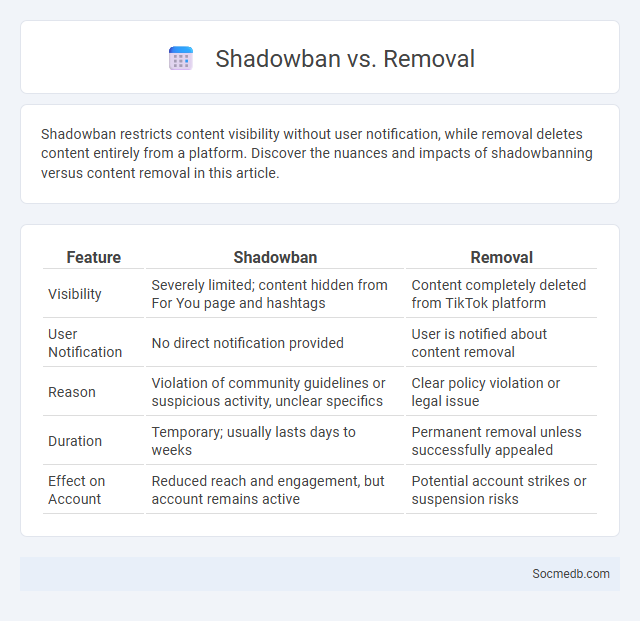
Photo illustration: Shadowban vs Removal
Shadowban restricts content visibility without user notification, while removal deletes content entirely from a platform. Discover the nuances and impacts of shadowbanning versus content removal in this article.
Table of Comparison
| Feature | Shadowban | Removal |
|---|---|---|
| Visibility | Severely limited; content hidden from For You page and hashtags | Content completely deleted from TikTok platform |
| User Notification | No direct notification provided | User is notified about content removal |
| Reason | Violation of community guidelines or suspicious activity, unclear specifics | Clear policy violation or legal issue |
| Duration | Temporary; usually lasts days to weeks | Permanent removal unless successfully appealed |
| Effect on Account | Reduced reach and engagement, but account remains active | Potential account strikes or suspension risks |
Understanding Shadowban: Definition and Impact
Shadowban is a covert restriction imposed by social media platforms that limits the visibility of Your posts without notifying You, often resulting in decreased engagement and reach. This action can occur due to violations of community guidelines or algorithmic misinterpretations, significantly impacting follower growth and online presence. Recognizing the signs of shadowban and adjusting posting habits can help restore Your account's visibility and engagement levels.
What is Content Removal? Key Differences
Content removal refers to the process of deleting or taking down digital content from social media platforms to address violations of community guidelines, copyright infringements, or other legal issues. Unlike content moderation, which involves reviewing and managing content based on platform policies, content removal specifically entails the permanent elimination of content deemed harmful, inappropriate, or unauthorized. You should understand that content removal policies vary across platforms, with key differences in enforcement procedures, appeal options, and the scope of removable content.
Decoding Shadowbanning: How It Works
Shadowbanning on social media restricts your content visibility without notifying you, significantly reducing engagement and reach. Platforms use algorithms to detect and limit posts that violate community guidelines or appear spammy, effectively hiding them from wider audiences. Understanding these mechanisms helps you adjust your content strategy to maintain authentic interaction and avoid penalization.
Shadowban vs Removal: Core Distinctions
Shadowban subtly restricts your social media visibility without notifying you, making your content harder to find or engage with. Removal entails a complete deletion of your post or account, often due to policy violations, and is clearly communicated by the platform. Understanding these core distinctions helps you recognize and respond effectively to changes in your online presence.
Signs You’ve Been Shadowbanned
Shadowbanning on social media can silently reduce your content's visibility without your knowledge. Signs you've been shadowbanned include a sudden drop in engagement rates, such as fewer likes, comments, and shares, and your posts not appearing in hashtag searches or follower feeds. Monitoring these indicators helps you recognize if your account's reach has been artificially limited, enabling you to take corrective action.
Reasons for Content Removal on Social Platforms
Social media platforms enforce strict guidelines to remove content that violates policies such as hate speech, harassment, misinformation, and copyright infringement. Content promoting violence, explicit material, or illegal activities is also subject to removal to protect community safety and adhere to legal regulations. Understanding these rules helps you maintain compliant content and avoid penalties on social platforms.
Shadowbanning Methods Across Major Platforms
Shadowbanning on major social media platforms like Twitter, Instagram, and TikTok involves reducing content visibility without notifying users, often by limiting hashtag reach, restricting video distribution, or hiding comments in moderation queues. These methods leverage algorithmic filtering and user behavior analysis to minimize harmful or spammy content while maintaining platform engagement and compliance with community guidelines. Understanding shadowbanning tactics helps users adapt their content strategies to improve organic reach and avoid inadvertent restrictions.
User Experience: Shadowban vs Removal
Shadowban limits a user's visibility on social media platforms without notifying them, causing diminished engagement and reduced reach. Removal, by contrast, fully deletes a user's content or account, resulting in immediate and complete loss of presence. Understanding these distinctions is critical for managing reputation and compliance within community guidelines effectively.
Preventing Shadowban and Content Removal
To prevent shadowban and content removal on social media platforms, consistently adhere to community guidelines and avoid spam-like behavior such as excessive posting or repetitive comments. Use authentic engagement methods, including interacting meaningfully with followers and employing relevant hashtags without overuse. Regularly monitor account analytics to detect any sudden drops in reach, indicating potential restrictions, and adjust content strategies accordingly.
Addressing and Appealing Platform Actions
Social media platforms implement targeted address features that enhance user engagement by allowing precise audience segmentation based on demographics and interests. Appeals within these platforms often utilize customized notifications and interactive content to boost user participation and retention rates. Optimizing platform actions to align with user behavior analytics drives higher conversion and brand loyalty.
 socmedb.com
socmedb.com